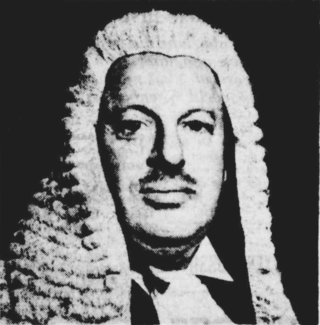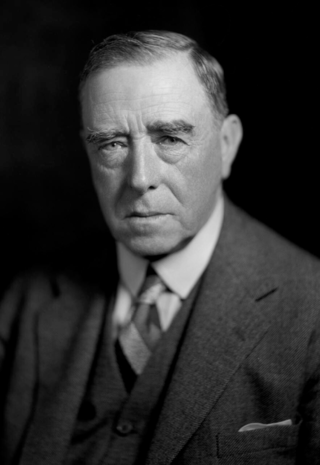
Sir Henry Edward BolteGCMG was an Australian politician who served as the 38th premier of Victoria from 1955 to 1972. He held office as the leader of the Victorian division of the Liberal Party of Australia (LPA) and was a member of the Victorian Legislative Assembly (MLA) for the division of Hampden from 1947 to 1972. He is the longest-serving premier in Victorian state history, having been in office for over 17 consecutive years.

Andrew Dawson, usually known as Anderson Dawson, was an Australian politician and unionist who served as the 14th premier of Queensland for one week from the 1 to the 7 of December 1899. This short-lived premiership was the first Australian Labor Party (ALP) government in Australia and the first parliamentary labour party government anywhere in the world.
The following lists events that happened during 1947 in Australia.
The following lists events that happened during 1952 in Australia.

Sir Albert Arthur Dunstan, KCMG was an Australian politician who served as the 33rd premier of Victoria from 1935 to 1945, and previously as the 3rd deputy premier of Victoria for five days in March 1935. A member of the Country Party, now the National Party, his term as premier was the second-longest in the state's history and the longest of any third-party premier. He was the first person to hold the office of premier in its own right, and not an additional duty taken up by the Treasurer, Attorney-General or Chief Secretary.

Thomas Tuke Hollway was the 36th Premier of Victoria, and the first to be born in the 20th century. He held office from 1947 to 1950, and again for a short period in 1952. He was originally a member and the leader of the United Australia Party (UAP) in Victoria, and was the inaugural leader of the UAP's successor, the Victorian division of the Liberal Party, but split from the Liberals after a dispute over electoral reform issues.

Sir John Gladstone Black McDonald was 37th Premier of Victoria from 27 June 1950 to 17 December 1952, except for a few days in October 1952 when Thomas Hollway led a brief Electoral Reform League government. McDonald came to office by defeating Hollway's Liberals, but was himself vanquished by the Labor Party under John Cain in 1952.

Trevor Donald Oldham was an Australian politician, who was the leader of the Liberal Party in the state of Victoria from 1952 until his death in 1953. The eldest of three sons born to Arthur and Ethel Oldham, he was educated at Melbourne Church of England Grammar School and the University of Melbourne. He had enlisted in the Australian Imperial Force on 7 November 1918, four days before the Armistice.
The Victorian Farmers' Union (VFU) was an association of farmers and primary producers formed in 1914 in the Australian state of Victoria. Although initially formed as an "absolutely non-political" entity, the VFU became a political party in 1916, and nominated candidates for the 1917 state election and subsequent elections. In later years it used the names Victorian Country Party, then United Country Party and is now the National Party of Australia – Victoria. At the 1917 election, because the support for the VFU was concentrated in rural seats, it won four of the 11 seats in the Victorian Legislative Assembly it contested, gaining about 6% of the vote state-wide. In 1918 it also won its first seat in the federal parliament, after preferential voting was introduced. At the 1920 state election the VFU vote increased to 8% and the number of seats to 13, giving the VFU the balance of power in the state Legislative Assembly.

Sir Archie Reuben Louis Michaelis was an Australian politician. He was a member of the Victorian Legislative Assembly from 1932 to 1952, representing the electorate of St Kilda for the United Australia Party and its successor. the Liberal Party.

The 1955 Victorian state election was held in the Australian State of Victoria on Saturday, 28 May 1955 to elect 65 members of the state's Legislative Assembly.
The Victorian Liberal Party (VLP), often called the Hollway Liberals, was an independent political party formed on 27 October 1954 from a grouping of supporters of Thomas Hollway, a former leader of the Liberal and Country Party and Premier of Victoria. The extant Liberal and Country Party was the actual Victorian division of the Liberal Party.

The 1950 Victorian state election was held in the Australian state of Victoria on Saturday 13 May 1950 to elect 65 members of the state's Legislative Assembly.

The 1935 Victorian state election was held in the Australian state of Victoria on Saturday 2 March 1935 to elect 53 of the 65 members of the state's Legislative Assembly. 12 seats were uncontested.

Major Sir Thomas Karran Maltby was a politician in Victoria, Australia. He was a member of the Victorian Legislative Assembly for nearly 32 years from 1929 to 1961, served in several ministries and was Speaker of the assembly from 1947 to 1950.
Keith Dodgshun was a politician in Victoria, Australia. He was a member of the Victorian Legislative Assembly for just under 17 years, representing the electorates of Ouyen and Rainbow for the Country Party from 1938 to 1955.
Sir John Herman (Henry) Lienhop was an Australian politician and grazier. He was the member of the Victorian Legislative Council for Bendigo Province from June 1937 to February 1951.
The National Party of Australia – Victoria is a political party in Victoria, which forms the state branch of the federal Nationals. It represents graziers, farmers, miners and rural voters.
The Second McDonald Ministry was the 58th ministry of the Government of Victoria, which consisted of members of the Country Party. It was led by the Premier of Victoria, John McDonald, and Deputy Premier Keith Dodgshun.

The Victorian Liberal Party, officially known as the Liberal Party of Australia (Victorian Division) and branded as Liberal Victoria, is the state division of the Liberal Party of Australia in Victoria. It was formed in 1944. It became the Liberal and Country Party (LCP) in 1949, and simplified its name to the Liberal Party in 1965. The party sits on the centre-right to right-wing of the Australian political spectrum.









